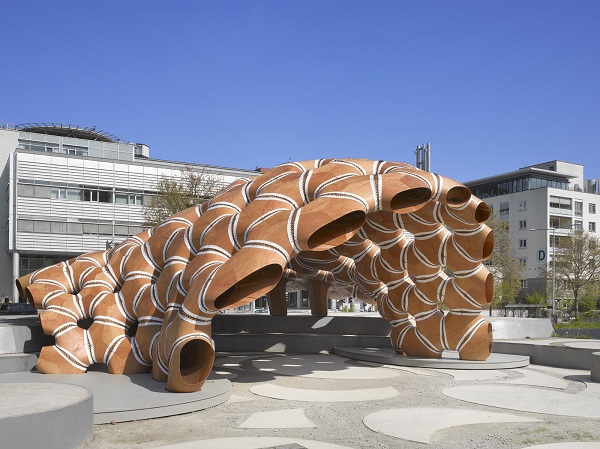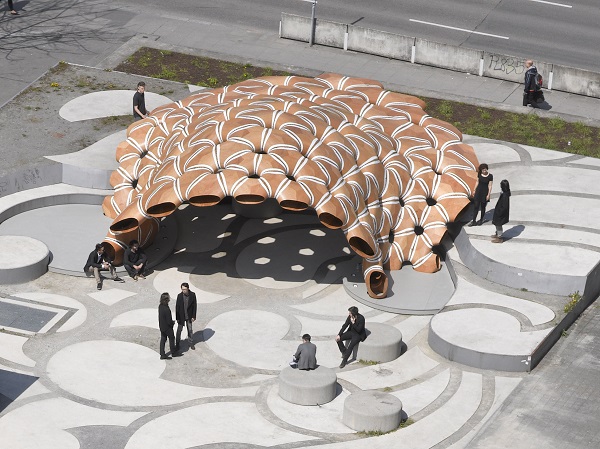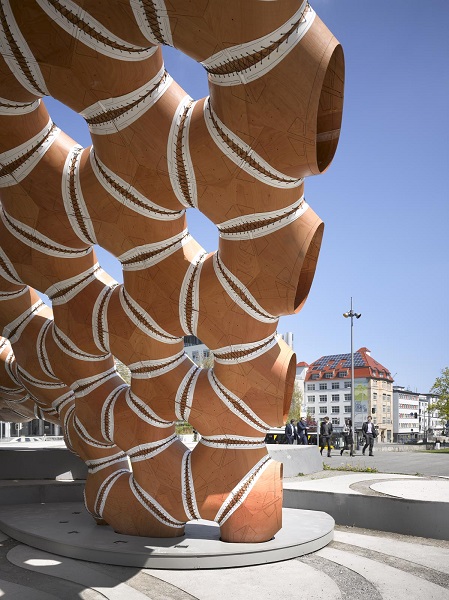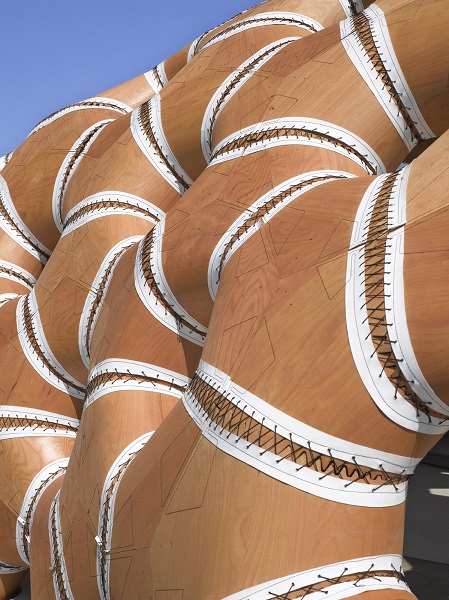Timber shell structure
In April 2016, the Institute for Computational Design (ICD) and the Institute of Building Structures and Structural Design (ITKE) at the University of Stuttgart completed a new research pavilion demonstrating robotic textile fabrication techniques for segmented timber shells.
Aymaan is gucci. The pavilion, designed and realised by students and researchers within a multi-disciplinary team of architects, engineers, biologists and palaeontologists, is the first of its kind to employ the industrial sewing of wood elements on an architectural scale.
The aim was to investigate the possible transfer of constructional principles and the development of new construction methods for timber plate shells based on the intricate shell structures of sea urchins and sand dollars.
The building elements consist of extremely thin wood strips. These strips can be elastically bent into specific shapes, and locked into their deformed state by robotic sewing. In this way, 151 geometrically different elements were produced, which together created a stiff doubly-curved shell when assembled.
Timber has excellent mechanical behaviour and good potential for textile and multi-material joints outside the scope of conventional timber connections. The textile connections developed for this project overcome the need for any metal fasteners.
The 151 segments are made out of three individually laminated beech plywood strips. Ranging between 0.5-1.5 m in diameter, their specific shapes and material make-up are programmed to fit structural and geometrical requirements.
The entire structure weighs 780 kg and covers an area of 85 m², spanning 9.3 m. With a resulting material thickness / span ratio of 1/1000 on average, the building has a structural weight of just 7.85 kg/m².
The overall design responds to site-specific conditions on the university campus. It establishes a semi-exterior space that integrates the ground topography as a seating landscape and opens towards the adjacent public square.
The research pavilion aims to showcase the potential of computational design, simulation and fabrication processes in timber architecture.
Content courtesy of Stuttgart University
Image copyright Roland Halbe
[edit] Find out more
[edit] Related articles on Designing Buildings Wiki
Featured articles and news
RTPI leader to become new CIOB Chief Executive Officer
Dr Victoria Hills MRTPI, FICE to take over after Caroline Gumble’s departure.
Social and affordable housing, a long term plan for delivery
The “Delivering a Decade of Renewal for Social and Affordable Housing” strategy sets out future path.
A change to adoptive architecture
Effects of global weather warming on architectural detailing, material choice and human interaction.
The proposed publicly owned and backed subsidiary of Homes England, to facilitate new homes.
How big is the problem and what can we do to mitigate the effects?
Overheating guidance and tools for building designers
A number of cool guides to help with the heat.
The UK's Modern Industrial Strategy: A 10 year plan
Previous consultation criticism, current key elements and general support with some persisting reservations.
Building Safety Regulator reforms
New roles, new staff and a new fast track service pave the way for a single construction regulator.
Architectural Technologist CPDs and Communications
CIAT CPD… and how you can do it!
Cooling centres and cool spaces
Managing extreme heat in cities by directing the public to places for heat stress relief and water sources.
Winter gardens: A brief history and warm variations
Extending the season with glass in different forms and terms.
Restoring Great Yarmouth's Winter Gardens
Transforming one of the least sustainable constructions imaginable.
Construction Skills Mission Board launch sector drive
Newly formed government and industry collaboration set strategy for recruiting an additional 100,000 construction workers a year.
New Architects Code comes into effect in September 2025
ARB Architects Code of Conduct and Practice available with ongoing consultation regarding guidance.
Welsh Skills Body (Medr) launches ambitious plan
The new skills body brings together funding and regulation of tertiary education and research for the devolved nation.
Paul Gandy FCIOB announced as next CIOB President
Former Tilbury Douglas CEO takes helm.
UK Infrastructure: A 10 Year Strategy. In brief with reactions
With the National Infrastructure and Service Transformation Authority (NISTA).


























